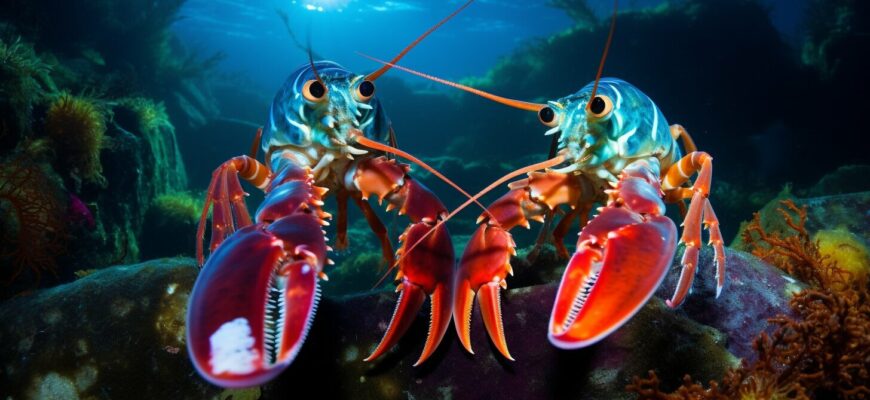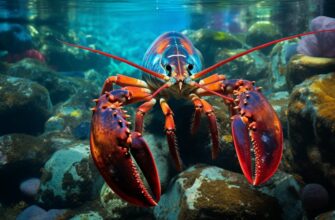Have you ever wondered how lobsters communicate with one another in their underwater world? Many scientists and lobster enthusiasts have sought to unravel the mysteries surrounding this unique form of communication.
Understanding how lobsters communicate is crucial to comprehending their social behavior, survival, and reproduction in their natural habitat. These creatures use various methods to convey messages to other lobsters, creating a complex network of communication that is essential to their survival.
But how exactly do lobsters communicate? Is it through sound, touch, smell, or visual signals? The answers to these questions have long been shrouded in mystery, but recent scientific research has begun to shed light on the intricate language of lobsters.
In this article, we will explore the different methods of lobster communication, the language they use to convey messages, how we can decode their unique signals, the behavior associated with their communication, recent research on lobster communication, and finally, answer some of the most frequently asked questions about these fascinating creatures.
- The Language of Lobsters
- The Chemical Signals of Lobsters
- The Antennae and Touch Communication of Lobsters
- The Visual Displays of Lobsters
- Decoding Lobster Communication Signals
- Key studies and findings
- Lobster Communication Behavior
- Decoding Lobster Sounds
- Recent Research on Lobster Communication
- Future Directions in Lobster Communication Research
- FAQs on Lobster Communication
- How do lobsters talk to each other?
- Can lobsters recognize individuals through their communication?
- How do lobsters communicate during molting?
- How far can lobster signals travel?
- Do lobsters have a language?
- Interesting Fact:
The Language of Lobsters
Communication is essential for survival in the animal kingdom, and lobsters are no exception. Lobsters use a variety of methods to convey messages to one another, including chemical signals, visual displays, and physical interactions. Understanding the language of lobsters is crucial to understanding their behavior and social structure.
The Chemical Signals of Lobsters
Lobsters release chemical substances called pheromones to communicate with each other. These pheromones are released into the surrounding water and act as signals to other lobsters. Pheromones can communicate a variety of messages, including the location of food, the presence of predators, and even sexual receptivity. Researchers have identified over 100 different types of pheromones used by lobsters.
The Antennae and Touch Communication of Lobsters
Lobsters also use their antennae for communication through touch and motion. They can touch each other’s antennae, which can convey information about their identity, dominance, or even mood. For example, a dominant lobster may use its antennae to push a subordinate lobster aside. The movement and direction of the antennae can also convey different messages.
The Visual Displays of Lobsters
In addition to chemical and touch communication, lobsters use visual displays to communicate with each other. They can raise their claws and flail their tails to signal aggression, courtship, or warning. For example, a lobster with its claws raised is often a sign of aggression, while a lobster with its tail flapping quickly can signal alarm. The color and size of a lobster can also indicate its social status within the group.
Overall, lobsters have a complex communication system that involves chemical, touch, and visual signals. Decoding their unique language can provide valuable insight into their behavior and social interactions.
Decoding Lobster Communication Signals
While lobsters use several methods to communicate, the challenge lies in understanding the meaning behind their signals. Deciphering their unique language requires careful observation and extensive research.
A series of studies have provided groundbreaking insights into decoding lobster communication. For instance, scientists have discovered that lobsters produce specific pheromones to signal mating and aggression. Additionally, researchers have identified various visual displays, such as the tail flip, that indicate submission or defense.
However, interpreting lobster communication is not always straightforward. Some behaviors have multiple meanings depending on the context, such as the tail flip, which can signify both submission and aggression. Moreover, individual lobsters may exhibit variations in their communication style, making it difficult to generalize their behavior.
Key studies and findings
In a recent study by Dr. Jelle Atema and his team, researchers used underwater recordings to analyze the sounds lobsters produce. They found that lobsters use a unique system of sound production to communicate. Specifically, they use their stomach muscles to generate sound waves that resonate within their shells, creating a distinct noise that travels through the water.
Another study conducted by Dr. Anna Sala and her colleagues explored the chemical signals lobsters produce during mating season. They found that female lobsters release specific pheromones that attract male counterparts, while males produce pheromones that signal their readiness to mate.
While these studies contribute to our understanding of lobster communication, there is still much to learn about their complex language. Ongoing research aims to explore how lobsters recognize individual signals, identify social hierarchies, and cope with environmental stressors through communication.
Lobster Communication Behavior
Lobsters have a complex social structure that is heavily influenced by their communication behavior. They establish dominance hierarchies based on physical size and displays of aggression and submission.
During interactions, lobsters use a combination of body postures, movements, and sounds to convey messages to each other. For example, raising the claws is a sign of aggression, while lowering them indicates submission. Lobsters also use their tails to communicate various messages, such as warning or excitability.
Interestingly, lobsters can also engage in ritualized combat to establish dominance. In this behavior, the two lobsters face each other, raise their claws, and engage in a shoving match. The winner of the fight is determined by the opponent’s retreat.
Decoding Lobster Sounds
While lobsters are typically silent creatures, they can produce sounds to communicate as well. Researchers have identified three types of lobster sounds: rasps, clicks, and scrapes. Rasps are created when the lobster rubs the ridges on its claws, while clicks are produced when the lobster quickly opens and closes its claws. Scrapes are created when the lobster drags its legs or antennae against its body.
It is unclear what specific messages these sounds convey, but researchers believe they may be used to establish territory or attract mates.
Recent Research on Lobster Communication
Scientific research on lobster communication continues to reveal fascinating insights into the behavior and social structure of these creatures. The methodologies used in these studies include underwater observations, experimental setups, and advanced data analysis techniques.
One recent study published in the Journal of Experimental Biology investigated the effect of background noise on lobster communication. The researchers found that increased background noise levels made it harder for lobsters to detect and respond to chemical signals, which are crucial for communication. This has important implications for understanding how environmental factors can impact the ability of lobsters to communicate effectively.
| Study | Key Finding |
|---|---|
| Research conducted at the University of Maine | Found that lobsters produce different courtship behaviors when they are in groups versus when they are alone. |
| A study from Dalhousie University | Showed that lobsters can recognize individual conspecifics using their chemical signals. |
Another recent study explored how lobsters use visual displays to communicate. The researchers found that lobsters use their antennules, small antennae on their heads, to transmit visual signals to other lobsters. These signals include specific movements and postures that convey information about the lobster’s mood and intentions.
Future Directions in Lobster Communication Research
While much has been learned about lobster communication in recent years, there is still much to discover. Researchers are continuing to explore the intricacies of lobster communication, including the role of individual differences in chemical signaling and the impact of changing ocean conditions on communication behavior.
Further research could also shed light on how lobsters communicate with other species and how their communication evolves over time. With the help of advanced technological tools and innovative research methods, the mysteries of lobster communication are slowly being unraveled, providing us with a deeper understanding of these fascinating creatures.
FAQs on Lobster Communication
Have you ever wondered how lobsters communicate with each other? Here are some frequently asked questions about lobster communication that might answer some of your queries:
How do lobsters talk to each other?
Lobsters talk to each other through various methods such as visual displays, chemical signals, and physical interactions. They use their antennae to touch and motion towards each other and release pheromones to convey messages. Different behaviors like postures, movements and sounds also carry different meanings in their communication.
Can lobsters recognize individuals through their communication?
Studies have shown that lobsters might be able to differentiate between familiar and unfamiliar individuals through their pheromones. However, more research is needed to determine the extent of their recognition abilities.
How do lobsters communicate during molting?
Lobsters communicate less during the molting period, which is a vulnerable time for them. They are more likely to avoid interaction and seek shelter until their exoskeleton hardens.
How far can lobster signals travel?
Lobster signals can travel up to several hundred meters, depending on the water conditions. However, they are more effective in close proximity.
Do lobsters have a language?
Lobsters do not have a formal language like humans do, but their communication system is complex and highly sophisticated. They use a combination of different signals and behaviors to convey messages to each other.
Interesting Fact:
Did you know that lobsters have two different types of pheromones – one type for attracting potential mates and another type for defending their territory?









